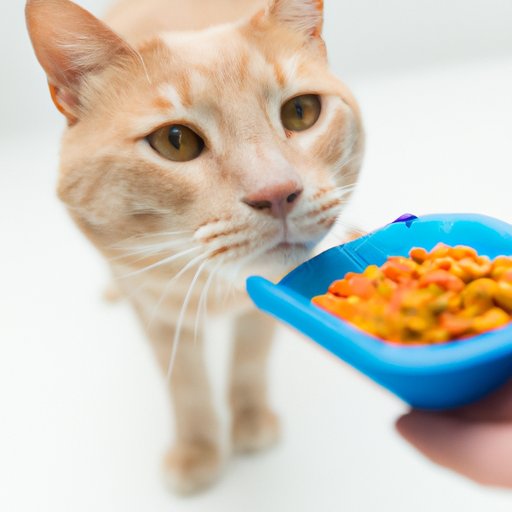Introduction
When cats become ill, it can be difficult to get them to eat. Not only do cats often lose their appetite when they are sick, but the medications and treatments prescribed by veterinarians can also have an effect on their eating habits. As a pet owner, it can be frustrating not knowing how to get your sick cat to eat.
The good news is that there are many things you can do to encourage your cat to eat. In this article, we will discuss various tips and tricks for getting a sick cat to eat, including offering small portions of appetizing food, heating up wet food, hand-feeding, using savory toppings or gravy, adding nutritional supplements, and offering variety in your cat’s diet. We will also explain when to seek professional advice from a veterinarian.
Offer Small, Appetizing Portions of Food
When it comes to getting a sick cat to eat, it is important to offer small, appetizing portions of food. Cats are more likely to eat if they are presented with small amounts of food that look and smell appealing. Start by offering just a few bites at a time and gradually increasing the amount as your cat begins to eat.
In terms of what type of food to offer, try to stick to something that your cat likes. If your cat prefers wet food, try to find a flavor that appeals to them. You can also offer dry food, but make sure to moisten it with a bit of water first. It is also important to serve the food in a shallow bowl so that your cat can easily access it.
Heat Up Wet Food to Release Aromas
Another tip for getting a sick cat to eat is to heat up wet food to release aromas. According to a study published in BMC Veterinary Research, cats prefer warm food over cold food. Heating up wet food can make it more palatable and appealing to cats, which may encourage them to eat. However, it is important to make sure that the food is not too hot before serving it to your cat.
To heat up wet food safely, microwave it for no more than 10 seconds at a time. Make sure to stir the food between intervals and check the temperature before serving.
Try Hand-Feeding
Hand-feeding can also be effective for getting a sick cat to eat. This involves offering small bits of food directly to your cat’s mouth. The benefit of this method is that it allows you to monitor how much your cat is eating and ensure that they are getting enough nutrition. It also creates a positive association between you and the food.
When hand-feeding, it is important to use caution. Make sure to keep your fingers away from your cat’s mouth and teeth and never force them to eat. Also, be aware that some cats may become anxious or aggressive when hand-fed, so use this method with caution.

Use Savory Toppings or Gravy
Using savory toppings or gravy can also be helpful for getting a sick cat to eat. Cats are naturally attracted to strong aromas, so adding a bit of gravy or other savory topping to their food can make it more appealing. Try to avoid anything that is too sweet, as this could cause an upset stomach.
When applying toppings or gravy, start with a small amount and gradually increase it as needed. Make sure to mix the topping into the food thoroughly before serving it to your cat.
Add Nutritional Supplements
Nutritional supplements can also be beneficial for sick cats who are refusing to eat. Many veterinary clinics offer nutritional supplements specifically designed for cats, such as liquid vitamins or appetite stimulants. These supplements can help to provide essential nutrients and encourage your cat to eat.
It is important to talk to your veterinarian before giving your cat any supplements. They can advise you on the best type of supplement for your cat and how to safely administer it.
Offer Variety in Your Cat’s Diet
Offering variety in your cat’s diet is another way to encourage them to eat. Cats can get bored with the same food day after day, so try mixing things up by offering different types of food. Wet food, dry food, canned food, and treats are all options to consider. You can also add fresh vegetables or fruits to their diet for added nutrition.
Talk to Your Veterinarian
Finally, it is important to talk to your veterinarian if your cat is still not eating. They can provide additional advice and may recommend further tests or treatments to help get your cat back on track. If necessary, they can also prescribe medication to help stimulate your cat’s appetite.
Conclusion
Getting a sick cat to eat can be a challenge, but there are many things you can do to encourage them. By offering small, appetizing portions of food, heating up wet food, hand-feeding, using savory toppings or gravy, adding nutritional supplements, and offering variety in your cat’s diet, you can help get your fussy eater back on track. If your cat is still not eating, talk to your veterinarian for further advice.
Remember, it is important to be patient and understanding when dealing with a sick cat. With a little bit of effort, you can help your furry friend get back to feeling better and enjoying their meals once again.
(Note: Is this article not meeting your expectations? Do you have knowledge or insights to share? Unlock new opportunities and expand your reach by joining our authors team. Click Registration to join us and share your expertise with our readers.)
